#history with anons
Note
As a Spaniard we even have a saying that Portugal has always been England's little bitch (to be fair Spain were cunts always trying to invade them so they became chummy with England because they always defended them) what was hilarious was that at the end of the day England stabbed Portugal in the back too 😂 (their only ally ever, and a loyal one!).
England's little bitch...... god what an embarrassing title to have. that's how we feel about Belorussia too 😵💫
Ty for the history lesson in a compelling way anon... also LOL to backstab your only ally..... america to france in 1789 💀
#blorbocedes ask#history with anons#this is very entertaining cause we all learn history a little biased to our countries and it shapes our world view
2 notes
·
View notes
Note
Rowling isn't denying holocaust. She just pointed out that burning of transgender health books is a lie as that form of cosmetic surgery didn't exist. But of course you knew that already, didn't you?
I was thinking I'd probably see one of you! You're wrong :) Let's review the history a bit, shall we?
In this case, what we're talking about is the Institut für Sexualwissenschaft, or in English, The Institute of Sexology. This Institute was founded and headed by a gay Jewish sexologist named Magnus Hirschfeld. It was founded in July of 1919 as the first sexology research clinic in the world, and was run as a private, non-profit clinic. Hirschfeld and the researchers who worked there would give out consultations, medical advice, and even treatments for free to their poorer clientele, as well as give thousands of lectures and build a unique library full of books on gender, sexuality, and eroticism. Of course, being a gay man, Hirschfeld focused a lot on the gay community and proving that homosexuality was natural and could not be "cured".
Hirschfeld was unique in his time because he believed that nobody's gender was either one or the other. Rather, he contended that everyone is a mixture of both male and female, with every individual having their own unique mix of traits.
This leads into the Institute's work with transgender patients. Hirschfeld was actually the one to coin the term "transsexual" in 1923, though this word didn't become popular phrasing until 30 years later when Harry Benjamin began expanding his research (I'll just be shortening it to trans for this brief overview.) For the Institute, their revolutionary work with gay men eventually began to attract other members of the LGBTA+, including of course trans people.
Contrary to what Anon says, sex reassignment surgery was first tested in 1912. It'd already being used on humans throughout Europe during the 1920's by the time a doctor at the Institute named Ludwig Levy-Lenz began performing it on patients in 1931. Hirschfeld was at first opposed, but he came around quickly because it lowered the rate of suicide among their trans patients. Not only was reassignment performed at the Institute, but both facial feminization and facial masculization surgery were also done.
The Institute employed some of these patients, gave them therapy to help with other issues, even gave some of the mentioned surgeries for free to this who could not afford it! They spoke out on their behalf to the public, even getting Berlin police to help them create "transvestite passes" to allow people to dress however they wanted without the threat of being arrested. They worked together to fight the law, including trying to strike down Paragraph 175, which made it illegal to be homosexual. The picture below is from their holiday party, Magnus Hirschfeld being the gentleman on the right with the fabulous mustache. Many of the other people in this photo are transgender.

[Image ID: A black and white photo of a group of people. Some are smiling at the camera, others have serious expressions. Either way, they all seem to be happy. On the right side, an older gentleman in glasses- Magnus Hirschfeld- is sitting. He has short hair and a bushy mustache. He is resting one hand on the shoulder of the person in front of him. His other hand is being held by a person to his left. Another person to his right is holding his shoulder.]
There was always push back against the Institute, especially from conservatives who saw all of this as a bad thing. But conservatism can't stop progress without destroying it. They weren't willing to go that far for a good while. It all ended in March of 1933, when a new Chancellor was elected. The Nazis did not like homosexuals for several reasons. Chief among them, we break the boundaries of "normal" society. Shortly after the election, on May 6th, the book burnings began. The Jewish, gay, and obviously liberal Magnus Hirschfeld and his library of boundary-breaking literature was one of the very first targets. Thankfully, Hirschfeld was spared by virtue of being in Paris at the time (he would die in 1935, before the Nazis were able to invade France). His library wasn't so lucky.
This famous picture of the book burnings was taken after the Institute of Sexology had been raided. That's their books. Literature on so much about sexuality, eroticism, and gender, yes including their new work on trans people. This is the trans community's Alexandria. We're incredibly lucky that enough of it survived for Harry Benjamin and everyone who came after him was able to build on the Institute's work.

[Image ID: A black and white photo of the May Nazi book burning of the Institute of Sexology's library. A soldier, back facing the camera, is throwing a stack of books into the fire. In the background of the right side, a crowd is watching.]
As the Holocaust went on, the homosexuals of Germany became a targeted group. This did include transgender people, no matter what you say. To deny this reality is Holocaust denial. JK Rowling and everyone else who tries to pretend like this isn't reality is participating in that evil. You're agreeing with the Nazis.
But of course, you knew that already, didn't you?
Edit: Added image IDs. I apologize to those using screen readers for forgetting them. Please reblog this version instead.
#transgender#trans history#transsexual#transphobia#Magnus Hirschfeld#holocaust#holocaust denial#book burning#j.k. rowling#jk rowling#just in case you missed what i mean by all this: go fuck yourself anon :)#trans people have always existed#and we will always exist#if you really wanna pick a fight with me over well-documented history then you better bring in some sources to back your shit#queer history#queer#lgbt+#lgbta+#lgbt#lgbt history#edit: i finally got around to those damn image IDs. i am so very sorry for totally forgetting that's my bimbo moment of the month#also real quick i thought about adding an image of the actual building but the only one i can find has a Nazi parade in front of it#it was taken the day of the book burning raid and honestly if i were to include it then i'd add it to the first few paragraphs#and i think the story's better told when you uphold the hope Magnus Hirschfeld and all the researchers he worked with had#also keeps being brought up: yes Hirschfeld was a eugenicist. it was a popular belief set that was only discredited after WW2#Hirschfeld died in 1935. he literally didn't live long enough to see science turn against those beliefs and practices#considering how he changed his mind on transitions i like to think he would've changed his mind on eugenics too if he'd lived
16K notes
·
View notes
Note
Since requests are closing in a few days, I just wanted to put another one in. No rush go get it done of course!
I want to request a oneshot/reaction where Alexander gives reader a really, REALLY expensive necklace. Maybe it's a wedding present, a just because present , or something following the birth of the twins. You can decide what you want to do with that 😁!
Also, I keep picturing a necklace made of opal??? Not only is it a stunning gem stone, but it was also thought to be the tears of Zeus in ancient Greece, which would be an interesting tie to Alexander. Again, it's just a suggestion. You can use whatever gemstone you want!
Thanks, and take care ❤️❤️❤️!
--O-
❝ 📜— lady l: this had been sitting in my drafts for a while and I finally decided to write it. I got a little carried away, so it's a little big, but I hope you like it and if you want to order anything else, feel free, anon! Good reading and forgive me for any mistakes! ❤️
❝tw: none, just fluff and very soft!Alexander.
❝📜pairing: yandere!alexander the great x female!reader.
❝word count: 1,308.
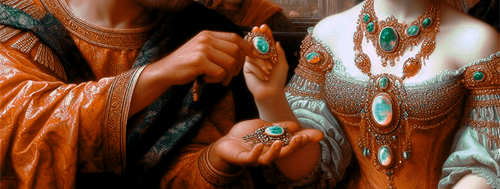

Alexander wanted to find something to give you. Something expensive and extravagant, something that would leave you impressed.
He felt like he owed you that. Not only had you given birth to his children, but you were loved by him and he wanted to please you. He thought of several options: a horse, silk clothes, food and even drink. He still wasn't sure what you might like.
Until he had an idea after talking to Hephaestion. He was the one who gave you the idea of giving you a necklace made from a special and rare gem. And he knew it was the right choice to make.
It was no easy task to get a merchant to have the necklace he liked and deemed worthy of you to wear around your delicate neck, but after the fifth try with a different merchant, he finally knew what your gift should be. He decided to gift you with an opal necklace, a jewel that reflected the beauty and mystery of his passion.
It would change color and he would know that it would look beautiful and graceful on your neck. Everything about you was beautiful and graceful, so the necklace would only stand out on you and no one else.
This opulent piece was adorned with the most dazzling opals that could be found in the entire Empire. Each stone sparkled with vibrant colors, dancing like the aurora borealis reflected in the starry night. The necklace was a unique treasure, a harmony of opalescent hues, displaying hues of celestial blue, emerald green, and royal purple.
The merchant who sold it told him a story about the necklace and it was this story that convinced him to buy it. According to the Persian merchant, legend said that opals were gifts from star spirits, who bestowed their blessings on those who used them with love and wisdom. The necklace was not just a piece of jewelry, but a source of magical power. Its colors and reflections were believed to contain the essence of nature, connecting the wearer to the spiritual realms and bringing fortune and protection.
Whoever owned the opal necklace was seen as a keeper of ancient secrets, an heir to the ancient magic that flowed through the precious stones. It was said that opal possessed the ability to amplify intuition and creativity, allowing the wearer to see beyond the ordinary, opening doors to new possibilities and inspiration.
After this explanation, Alexander knew that this necklace must be yours. Not just because of your story, but because of who you were. From when you really came. No one was more worthy than you.
There was also another version of the story that convinced him to buy it. Knowing how religious Alexander was, the merchant also told him that the opal was made from the tears of Zeus. Long ago, at the beginning of Greek civilization, when the gods walked among mortals, Zeus, the mighty king of the gods, shed tears of joy and sorrow over human fate. These tears, upon touching the earth, transformed into radiant stones known as opals, carrying within them the duality of emotions of the great god.
Thus was born the opal, a legendary gem forged by Zeus' own tears. Each stone was shaped from divine emotions, capturing the essence of heaven and earth. Its unique iridescence reflected not only the colors of the rainbow, but also the contrasting feelings of joy and sadness, hope and despair, harmonized in an eternal dance of light and shadow. Ancient sages believed that the necklace was not just a manifestation of beauty, but rather a link between mortals and the gods. It was said that whoever wore the opal necklace would be enveloped in the protection of Zeus and would have the divine wisdom to navigate life's challenges.
And maybe when little Aella grew up, he could give her a necklace similar to the one he chose for you.
He smiled at the thought and with the necklace inside a small wooden box with gold ornaments, he walked to the room you shared in the Babylonian palace. Straightening his posture, Alexander knocked on the door and after hearing a soft ''come in'', he opened the door and smiled widely when he saw you sitting in a padded chair with Aella in one arm and Cyrus in the other. He fell silent when he realized the twins were asleep.
You looked at him and smiled softly when you saw what he had in his hands. Alexander placed the box on a table next to the bed and approached you, carefully taking Cyrus in his arm. You smiled lovingly when you saw him cuddling the baby in his arms.
Whispering, Alexander says, ''I have something for you.''
You smiled and asked curiously, ''What is it?''
Alexander carefully picked up the box with the arm that wasn't swinging Cyrus and placed him on your lap, looking at you expectantly. You smiled and opened the box with a little difficulty due to the sleeping child in your arms. Your eyes widened when you saw the lush opal necklace. You had never seen such beautiful jewelry.
Alexander, who was watching you like a hawk, smiled at you.
''Alexander, that's…'' You swallowed and took the necklace in your hand, carefully observing its details. The necklace was a magnificent piece, a heavenly masterpiece that captivated the eyes of all who dared to gaze upon it. Every aspect of the necklace was a symphony of intertwined beauty and magic.
The centerpiece of the necklace consisted of a main opal, a generously sized gem that radiated an unparalleled iridescent glow. This central opal was an explosion of celestial color, with soft, shimmering hues that moved like an aurora borealis trapped within the gemstone. Its tones ranged from the deep blue of twilight to the lush green of enchanted forests, and occasional glimpses of the deep red of divine fire.
Around the main opal, a series of smaller opals were skillfully arranged, forming a necklace that seemed to have been woven by the stars' own hand. Each smaller gem had its own color personality, some glowing an ethereal blue, others a crystalline green, and still others with purple and gold hues reminiscent of the sun setting over distant mountains.
The structure of the necklace was as intricate as the reflections of the opals. Delicate strands of gold wove between the gems, creating a sparkling frame that complemented the iridescence of the opals. Small, intricate metal sculptures, decorated with designs that resembled star constellations, adorned the necklace, giving it an aura of ancient magic.
''Do you like it?'' Alexander asked after you remained silent, observing the necklace with a strange expression.
''I loved it.'' You whispered, admiring the necklace. Alexander walked over to you and took the necklace from your hands and placed Cyrus back in your arms, careful not to wake him. He stood behind you and removed your hair from your neck, placing the magnificent necklace around your neck. You closed your eyes when you felt the touch of his calloused fingers on your skin and sighed when the necklace was placed on you.
''I'm glad, it suits you.'' He kissed your neck affectionately and you closed your eyes, smiling.
Alexander leaned closer to your ear and whispered, ''When I heard the story about the opal… I knew it would have to be yours and yours alone.''
You opened your eyes and turned your head, looking at him. ''And what is this story?''
Alexander smiled widely and after kissing your forehead, he began to tell you both stories he had heard from the merchant. You just listened in silence, delighting in his words, with your sleeping children on your arm and the weight of the beautiful necklace around your neck.
Your small, loving family.

#history#yandere history#yandere historical characters#yandere alexander the great#yandere alexander the great x reader#alexander the great x reader#tlq#the lost queen#reaction#imagine#o- anon#yandere imagine#yandere reaction
400 notes
·
View notes
Text
sort of in the vein of that last post, the queer slurs have a degree of interchangeability in my opinion. nobody's asking your specific identity before they call you a dyke or a tranny or whatever. I know a guy who's straight as an arrow who used to get called a fag on the regular. you know why? he likes arranging flowers and interior decorating. that's it.
we're really not supposed to be split up into little factions the way the community's been going. we all face this shit together. we help each other when everyone else turns their backs on us. fags saying dyke and dykes saying fag is, in that sense, an act of solidarity
#the fairy rambles#ive been thinking about this quite a bit since that anon#and also just thinking about the history of our community and how divided we are now#not a heritage post
344 notes
·
View notes
Note
omgomg What hornyposting have they done - same anon :3c
check out my fuck energy tag for receipts on varying levels of overtly horny moments to things that ping for me but possibly not universally. but also, an in depth but not exhaustive list:
they have a bondage bar on their bed which dan has flippantly replied to a tweet about
sister daniel video
the april fools nude
dan probably agrees that phil is naturally ginger despite his hair color being an auburny brown at best due to pube color. sorry that i said it out loud rather than keeping it implied.
interactive introverts shock buzzers shown im witl were bought from an online sex store, dan told us on twitter
halloween pumpkin carving video has "so horny they're stupid" energy, dan's in a mesh shirt
this ii era liveshow in australia; the next video on the gaming channel was of the dumber ways to die mobile app.
ii era "getting that d vitamin" shirtless dan selfie ft clothes in the bushes behind him. photo taken on a brief break from touring when dnp + martyn and cornelia were spending a few days on vacation. "lapping up the d vitamin" comments about phil as well in a liveshow afterwards
phil's ii era side to side by ariana grande insta story
phil's mysterious white stain on his costume shirt insta story from the lead up to ii
"please be gentle with the handcuffs, i have sensitive skin" from witl/ii—sensitive skin is usually about like.. being sensitive to scented soaps and stuff. this is not an intuitive connection to make. it leads me to believe that's knowledge they have from experience
when the ii dvd was released, the bbc rated it whatever it rated it (can't remember) because of a couple engaging in erotic roleplay (amongst other reasons) which dan acknowledged on twitter and did not disagree with at all
dan's horny attitude about dentist visits
handcuffs and videogames sims moment
dan's kinky tumblr reblogs from the era when it was normal to rb softcore porn on here, including a fair amount of horny qbout blood posts
in that light: dan wrote and published the urge
phil bringing up mpreg as often as he does pings as horny for me; the hand falls into this category in a deeply bizzare manner imo
phil recognizing a delivery guy from gay emo porn
dan hogtied in christmas garland on their breakfast bar in manchester
dan's 2009 nakedbooths—nudes posted largely to flirt with phil. particularly the nakedbooth dan posted of himself in phil's bedroom where phil's holding lion in frame to censor dan's dick
phil's "milk" dailybooth
dan's "i WANT you to tie me up" dailybooth comment on phil holding up a belt
dan on formspring answering whether he swallows or spits
dan replying to someone in the comments of a phil vid pointing out hickies he had after dan visited him in 2009
uma thurman tweet
formspring answers about cherry & piña colada lube + cherry reference in the vday vid + sleuths online spotting specific lube in one of their suitcases at one point
phil used to post constant thirst traps before dan came into the picture have you SEEN ry @dnphobe's emo boy edit?? have you seen phil's check yes juliet and toxic vids????
thank you for coming to my ted talk, i know i'm missing loads.
151 notes
·
View notes
Text
Known driver hater Daniel Ricciardo talking about being glad he was FAR AWAY!! in the US while the other drivers kept bumping into eachother in Mykonos :
Also Daniel:
1. With Lewis in Coachella
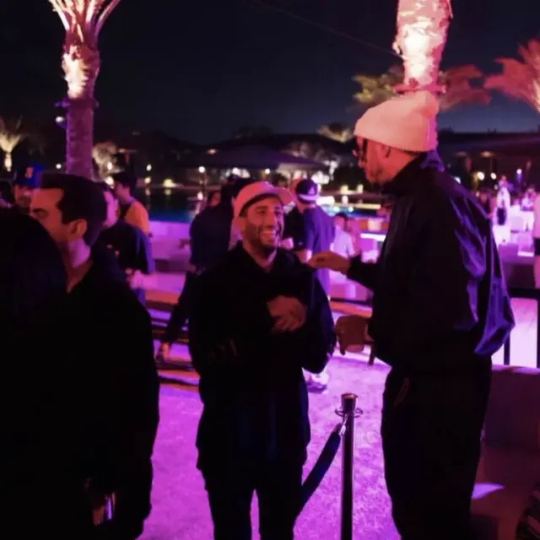
2. With Max and his Dutch friends

3. With Charles in Vegas:


4. With George in Ibiza

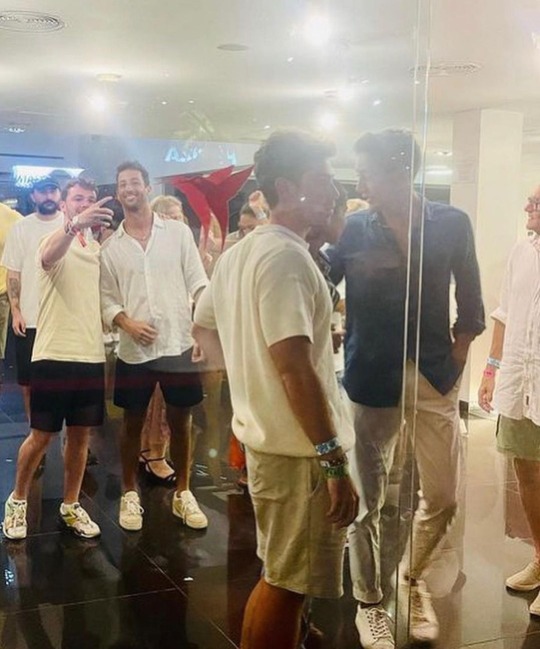
you really attract what you fear
#is this reverse manifestation#this is for anon who sent the history of daniels holidays and the [redacted] and [redacted] comparison youre SO right💋#daniel: i hate these mfs so much do NOT let any of them near me when im on vacation!!!#daniel when he sees one of the mfs-#:D!!!#f1#daniel ricciardo#lewis hamilton#charles leclerc#max verstappen#george russell
471 notes
·
View notes
Note
can you elaborate more on steve being abandoned by the narrative?
yes <3 so i think there are two very unfortunate circumstances surrounding steve's character that have led to the current state of his plotline: 1. after not killing him in s1 like they originally planned, the duffers have never really had a plan for steve and 2. they are extremely influenced by audiences. when they were conceptualizing steve to fit in among the ensemble cast, the duffers were picturing him as a douchey boyfriend who unceremoniously dies. lonnie was originally going to come back to the byers house to save jonathan and nancy. there was no need to picture where he'd be 4 seasons down the road, so they just didn't account for that. then joe keery charmed them so hard that they literally couldn't bear to kill him, so steve ends season one still somehow alive.
but we've already established the nancy/jonathan plotline, because jonathan was once the duffers' self-insert who must defeat the evil jock and win over the girl. they couldn't just backpedal on that right away, so they needed to give nancy and jonathan a plotline alone, away from steve. but steve only ever functioned as an extension of nancy until this point, so what do we do with steve now? in an accidental stroke of genius that the duffers have admitted was a last second decision, they pair him with the children and make him into a babysitter. it almost instantly boosts steve into being tied with hopper and el for most popular character from the show, potentially even beats them both out. in 2017 when s2 aired, you could not escape mom steve jokes. it was everywhere, steve was everywhere, joe was everywhere, it was arguably the second coming of #justice for barb, which, in netflix business-y terms, was the exact viral meme type situation that the show wanted and needed to sell merch and remain relevant and say "see we still got it!!!"
you know who has the 2nd most lines in the entirety of season three? directly behind hopper? ahead of winona ryder? steve. think for a second about how absolutely insane that is. the character who was written specifically to die in season one. joe keery's name wasn't even in the season one credits, because he wasn't considered a series regular. and now he has the 2nd most spoken lines in the big blockbuster season because he rocketed up in popularity so intensely. season three marketing features the mall so heavily, creates a literal physical shrine to 80s nostalgia, and when the very first promo is released an entire year before the season airs, who's the star of that teaser trailer? and who, pray tell, is featured in the main brand sponsorship ad that plays in movie theaters worldwide? thats right its america's little darling steve harrington.
but here is the issue. the duffers look at what made steve popular and they see: funny exasperated babysitter, heartthrob action hero. they're like oh okay so we should keep putting him directly in the center of the action, bang him up every season to give him his classic bloodied aesthetic, but. he still needs to be funny. we can almost kill him, but we can't actually kill him because he's profitable. we can let him get horrifically injured because it's badass, but we still gotta let him crack jokes. it creates this very weird tone to steve's role in the story starting in season 3 because he's both the action hero and the comedic relief and protected by plot armor, so we get scenes where he's being literally tortured until he's begging for his life and gasping for breath but the tone is still.......fun? comedic? light and goofy? i think the duffers also forgot he's supposed to be a teenager.
now this is partially me making educated guesses but i feel pretty confident about this: once again, like gollum, joe keery uses his big shiny eyes and manages to evade death again in season four by being so likable and charming and marketable that netflix execs or shawn levy or maybe even the duffers themselves were like oh fuck we just can't do it. they were obviously tossing around the idea of taking mom steve all the way by letting him die sacrificially for dustin, so in season four they make eddie, transfer steve's relationship with dustin directly onto him, ctrl f steve's name in the death scene and just type in eddie instead, and once again steve is alive but he's directionless.
so what does he have now, in season four? i think the duffers have a whiteboard somewhere with steve's name and around it are little circles that say "funny" "cool" "DO NOT KILL" and steve is now stuck in this endless cycle of getting beaten up, popping back up somehow unharmed like a looney tune, saying something cute and oblivious, rinse and repeat. because that's what worked, that's what made him popular all the way back in season two. that's what the duffers are obviously keeping in mind when they're writing steve: popularity. not realism, not depth, not growth, just literally how to continue making him popular. meanwhile, other characters get to be part of the actual story. other characters get to serve a purpose other than selling merch. when el is bitten by a monster, she gets to actually feel pain and need help because that's realistically what any human would need. when hopper is tortured, he gets to suffer and ponder his existence and reflect on the relationships in his life. steve never gets any of that, because the writers just don't see steve as the 19 year old boy on his 4th straight year of traumatic events that he actually is.
they literally just see him as a money maker, there for cool viral moments and witty lines and maybe the occasional emotion experienced but only if it's about his romantic prospects. and the narrative that other characters get to have and be apart of just kinda runs parallel to steve. he's there, technically, but he's not really in the story. and it's like actually crazy because you'd think after all the funko pops he sold, he'd have earned an actual storyline!!!
1K notes
·
View notes
Note
Hello, in fic I've come across mentions of
- the elves stopping frequently on their journey to Aman to have sex (and Orome urging them forward by creating storms?)
- elf sex being too intense for most mortals to survive
I think these come from HoME or NoME (or similar sources), but I've never seen the actual quotes. There might be other things related to elf-sex in there as well.
So I guess my question is: What else did Tolkien mention about elf sex, apart from (the already relatively well-known) LaCE?
Elf Sex Lore
There comes a time in every Tolkien fan’s journey when they come upon the Professor’s writings on Elf sex — and, since 2021, there are even more! Elf Sex Lore remains a hot topic as the fandom continues to experience the aftershocks of the spurt of new lore that came with the publication of The Nature of Middle-earth (NoMe) in 2021.
As you say Anon, before NoMe was published, the fandom’s primary resource on Elf sex was the (in)famous essay Laws and Customs Among the Eldar (LaCE), published in 1993 in Morgoth’s Ring, the tenth volume of the History of Middle-earth series. LaCE is full of juicy (or not-so-juicy) lore about Elven aging, marriage, gender roles, naming, death, and rebirth.
It is in relation to the first two that we get some details on Elf sex, such as the knowledge that “it was the act of bodily union that achieved marriage, and after which the indissoluble bond was complete.” (Laws B). We also learn that:
“…the Eldar say* that in the begetting, and still more in the bearing of children, greater share and strength of their being, in mind and in body, goes forth than in the making of mortal children. For these reasons it came to pass that the Eldar brought forth few children; and also that their generation was in their youth or earlier life, unless strange and hard fates befell them. But at whatever age they married, their children were born within a short space of years after their wedding. For with regard to generation the power and the will are not among the Eldar distinguishable. Doubtless they would retain for many ages the power of generation, if the will and desire were not satisfied; but with the exercise of the power the desire soon ceases, and the mind turns to other things. The union of love is indeed to them great delight and joy, and the ‘days of children’, as they call them, remain in their memory as the most merry in life; but they have many other powers of body and of mind which their nature urges them to fulfil.”
The History of Middle-earth Vol. 10: Morgoth’s Ring, ‘The Later Quenta Silmarillion (II)’, Laws B
*Note how this paragraph is introduced: “the Eldar say”. Phrases like this signal to us that LaCE is not written from a Elvish point of view. There are indications elsewhere clearly pointing to a human author with a human audience in mind.
Translation: Elves use up a lot of energy in baby-making, including in the sex part (“begetting”) but even more in the pregnancy and birthing part (“bearing”), so they don’t have a lot of children and they do so early in life, shortly after marriage. But even if they marry later in life, Elves are still able to have babies because being able to and wanting to reproduce are the same thing for Elves. But once they’ve fulfilled the desire to make babies they’re good and turn to other things. Still, they look back on the time of baby-making as “the most merry in life”.
In most (if not all) cases, when Tolkien writes about sex he is writing about reproduction. Did Elves have sex solely for pleasure? Maybe; I cannot find anything that says they didn’t. I also can find little conceptual separation of sex and reproduction in Tolkien’s writings. Make of that what you will.
(At this point I want to reiterate a principle central to this blog: it’s about presenting what canon says; it is not about casting judgement on creations that subvert, reinterpret, or ignore canon, none of which makes a work lesser than one which adheres strictly to canon.)
So what did NoMe add to our knowledge about Elf sex? First of all, let’s make sure we all know what NoMe is.
What is The Nature of Middle-earth?
NoMe is a volume of texts by J.R.R. Tolkien collected and edited by Carl Hostetter. It is basically a supplement to the last three volumes of The History of Middle-earth (Morgoth’s Ring, The War of the Jewels, and The Peoples of Middle-earth), which cover a period from the late 1950s to his death during which Tolkien was undertaking a rather massive project of worldbuilding, working out the structures underlying his Silmarillion mythology in preparation for revising and publishing what he had written of it before ‘a sequel to The Hobbit’ (LotR) took him away from it for the better part of two decades.
Christopher Tolkien in Morgoth’s Ring called this undertaking “analytic speculation concerning [the] underlying postulates” of his world (Foreword to Morgoth’s Ring). That’s how we end up with essays like LaCE and the philosophical debate about the fates of Men and Elves in Athrabeth Finrod ah Andreth.
The texts in NoMe all date to around the same time and deal with the same sorts of questions about the physics and metaphysics of the world: it contains the essay on ósanwë, for example.
The Context of the NoMe Sex Lore
The first section of NoMe, ‘Time and Ageing’, is where we get the new lore on Elf sex. As it happens, the sex lore is rather incidental to extensive ruminations two core questions:
How did Elves experience the passage of time and how did they age?
How did the population of Elves go from 144 at Awaking to a sufficiently high number (around 30 000) when they reached the shores of Beleriand on the Great Journey?
(It is not relevant to get into why 144 and why 30 000 here; suffice to say those are the numbers Tolkien wanted and he expended great imaginative and mathematical energy trying to make them work.)
A note on the textual context: Anyone who has ever engaged in worldbuilding knows how it can go. You think (for example), “Okay, I need to develop a backstory for this character’s spouse,” and before you know it you are knee-deep in invented genealogies and geographies and Eru-knows-what-else.
It’s important to bear in mind that this is what Tolkien was doing. The quotes we are about to look at (yes, very soon!) are from a collection of evolving (and unresolved) notes in various states of refinement from barely legible scribbles to carefully penned essays. I will let you decide what that means to you based on your personal definition of canon, but I wanted the textual context to be clear.
Elf Sex Is Intense
In relation to Question 1, Tolkien considers the time-scales of Elven growth, including pregnancy. In the essay under discussion, Tolkien decides that Elven pregnancy should, like human pregnancy, take about 3/4 of a year. Oh no - not that kind of year. A yên, a ‘long year’, the unit used by the Elves and to which the matter of their bodies (their hröar) is bound. Elves gestate for 108 Sun years.
I know what you’re asking: If the pregnancy lasts 108 years, then how long does the sex last?
No? No! You’re probably asking yourself why Tolkien hated Elf-women so much (don’t worry, he says there’s no pain…)! But Tolkien was interested in the first question, which he answered thus:
“On the other hand the act of procreation, being of a will and desire shared and indeed controlled by the fëa, was achieved at the speed of other conscious and wilful acts of delight or of making. It was one of the acts of chief delight, in process and in memory, in an Elvish life, but its intensity alone provided its importance, not its time or length: it could not have been endured for a great length of time, without disastrous “expense.”” (NoMe, p. 24)
An earlier version of this passage, which you may also come across in fandom, comes to a similar conclusion:
“But the act of procreation not being one of growth until the union of the seed and being under full control of the will does not take long - though it is longer and of more intense delight in Elves than in Men: too intense to be long endured.” (NoMe, pg. 27)
Translation: Pregnancy, like other aspects of physical growth, is a process of the hröa over which the fëa has no control; thus it is bound to unfold on “Elvish time”, i.e. 1 year = 144 years. But the sex leading up to it is an act of the fëa and under its control and therefore occurs at a “normal” speed. The Elves love it, too! But not because of how long it lasts, which is a regular amount of time, but because of how intense it is. In fact, it is so intense that if it were any longer they would suffer “disastrous “expense”.”
What is this “expense”? Basically, it’s referring to the usage of an Elf’s natural “vitality” — far greater than that of Men but not infinite. As far as I can tell, this passage means that having intense Elf sex for too long would have spiritual results similar to Míriel’s bearing of Fëanor, or Fëanor’s creation of the Silmarils. Too much of their spirit would be expended (used up) in the act, with possibly disastrous consequences.
These are the quotes from which, I think, originate the rumour that Elf sex was too intense for mortals to survive. As you can see, the discussion is about Elf/Elf relations. Elf sex is too intense for Elves to endure for too long. Anything about what this means for Elf/Mortal sexual relations is fan conjecture.
That’s the Elf Sex nugget from Tolkien’s considerations of Elven growth rates: Elf sex (between Elves) is intense but of a normal duration.
Elven enthusiasm for baby-making delays March
As you can imagine, more nuggets are unearthed in relation to Question 2, which boils down to Tolkien crying: “I need the Cuiviénen Elves to breed a lot and quickly!”
Initially, Tolkien developed some Elven life cycle schemes that had them taking a leisurely approach to reproduction, with each generation taking many hundreds, even thousands, of Sun years to materialise.
This scheme did not work for getting him from 144 to ~30k in the timeframe he wanted. So, he made some adjustments to the scheme with respect to the timing of Elven maturity and consequent desire to begin reproducing — and then set about getting those Elves procreating!
One of the solutions he entertained was giving the Elves opportunities to reproduce on the Great Journey. He laid all of this out in a timeline (NoME, p. 49-53) detailing where and for how long the host of Elves would pause because of the “desire to beget children” (p. 49).
Reading this timeline, it can become increasingly comical each time this desire to reproduce (i.e., have sex) halts the host. It can start to read like, “The Elves took forever to cross Middle-earth because they couldn’t stop banging!” And, in a way, that is what happened. But bear in mind the context is an attempt at solving the problem of increasing the Elven population to a number Tolkien considered satisfactory for his worldbuilding endeavours. An Elven enthusiasm for sex is there, but it’s not the whole picture.
There are several points on the timeline when Oromë hangs out with the Elves or checks in on them, and he does become increasingly concerned with their begetting-related delays. For example:
“About 2000 pairs (of available Telerin 8th gen. of 4,950) beget children in the spring 1130/80. The Chiefs and Oromë are disturbed.” (NoMe, p. 51)
(“The Chiefs” are Ingwë, Finwë, and Elwë.)
And:
“Either by chance, machinations of Sauron, and/or because Oromë withdraws protection (hoping to make the Eldar less content with their new Home (Atyamar), winters are hard and the weather worsens.” (NoMe, p. 51)
The second quote is the origin of that rumour about Oromë creating storms to urge the Elves on because they were having too much sex. Is it canon? Not quite: Oromë didn’t create the storm, for one, and the emphasis is on sex for the pleasure of children more than the pleasure of sex on its own (though, as we know from the previous discussion, sexual pleasure was certainly had!). But the rumour you've heard is not without basis in Tolkien’s notes.
The First Elves Really Loved Sex
There’s one more Elf sex nugget in NoMe that I’d like to end with. While scrambling to get his Cuiviénen Elves reproducing at an adequate rate to reach his population-at-finding target, Tolkien came up with what he calls the “Quick prolific” scheme (p. 99).
“The Quendi in their first few generations before the March (or reaching Valinor) must — as is quite reasonable — be made far more eager for love and the begetting and bearing of children. *They must have larger families, at shorter intervals between births.” (p. 107)
To explain this attitude of reproductive eagerness in the first few generations of Elves, Tolkien coins the term “philoprogenitive” — they love to procreate! Procreating — not artistic and intellectual pursuits or exploration or leadership as with later generations — is their number one priority in life. So much so that “they mated almost at once with their predestined mates” (p. 54).
Not only that, but they have so many babies! In one version of the scheme, 12 children per couple in the first generation (p. 108). (This soon changes to 6 per couple. Philoprogenitive they may be, but no one gets to outdo Fëanor).
As with the highly intense Elf sex and the Great Journey delayed by procreating, this is another bit of NoMe lore with great imaginative potential. As we learn from LaCE, Elves enjoyed sex, quite a bit actually, but they enjoyed a lot of other things also, and after a period of baby-making they would usually move on from sex (though they would always remember it fondly). But the First Elves, those early generations by the shores of Cuiviénen? No such balance between sex and other pursuits. It was all about sex and procreation for them.
Of course, what we’ve been looking at are drafts and notes. While all written around the same time (late 1950s to early 1960s), none of the texts here examined were ever finalised and many of them don’t even agree with each other. Tolkien was experimenting; he was worldbuilding. And with the publication of these notes in NoMe, we in turn get some intriguing ingredients for worldbuilding of our own.
So, do as you like with the Elf sex lore. But if you’re looking for a great setting for some canon-compliant smut, may I suggest Cuiviénen?
Resources
PDF of LaCE
Mythgard Academy’s seminars on The Nature of Middle-earth. You don’t actually have to have read or own NoMe to follow these discussions. Great for getting a handle on the material, and ideal for listening as you work your way through reading.
#nature of middle-earth#history of middle-earth#laws and customs among the eldar#anon#happy valentine's day
191 notes
·
View notes
Note
Draw him reacting to your browser history
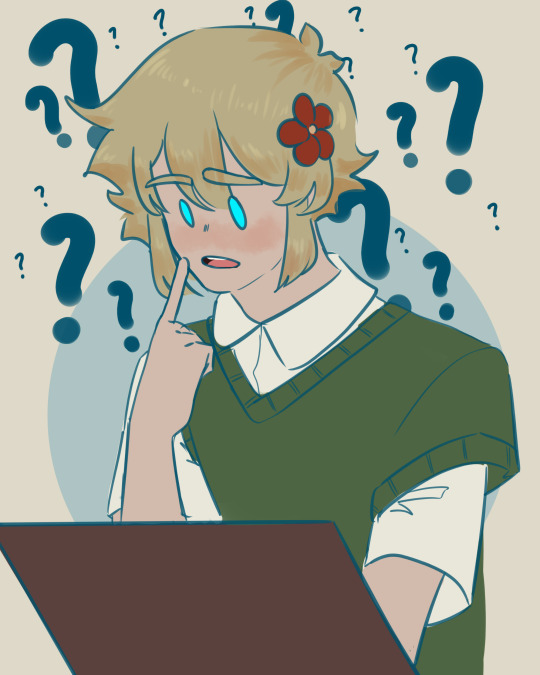
"Why is my name in there so many times? What's Archive of Our Own? Is that a mental health forum??"
#he has so many questions.#my search history is pretty clean actually#art#daily basil#drawing#omori#digital#omori basil#basil#basil omori#anon#request
198 notes
·
View notes
Note
Portuguese here, Portugal and England do have the longest alliance on the world. We know how it looks when people see it on the outside but they were the only ones who ever defended us, Spain was always being Spain too us and England hated them so an alliance of convenience started and lasted. It ran smoothly for centuries until they betrayed us too. Everyone made fun of us but at the end of day we came back to them all the same. (so friendly together that we even copied the atrocities they did 😒). Anyways sorry for the Ted talk, and happy birthday!
not portugal and england having a toxic codependent relationship....... when he cheats but you open the relationship to poly (colonisation) to save the marriage 🥴
but I do understand not biting the hand that feeds you esp if your neighbour keeps trying to fuck you... a la current South Korean/USAmerican relations wrt North Korea/China, thank you for the Ted talk and the birfday wishes
1 note
·
View note
Note
WHY NO ONE IS TALKING ABOUT THE 'STALKING HIM UNTIL HE LOVES YOU' MOMENT I FORGOT IT EXISTED SO NOW EVERYONE SHOULD TALK ABOUT IT
right??! he’s so real for that
295 notes
·
View notes
Note
Ok, so In your response to my last spiel, you mentioned that Alexander will have a zero tolerance policy towards anything that may harm Reader and her the twins, including other wives.
It does make me wonder how Alexander would react to one of the wives (aka Roxanna 👀👀👀) trying to kill our girl. I keep picturing this scenario where it's a banquet, feast or some sort of get together with Alexander, Reader, Roxanna and maybe some of the generals. Long story short, Roxanna hands Reader a cup with a 'special' drink (ie she says promotes health, will help with the pregnancy etc). Reader, being as smart as she is, and knowing Roxanna's history, is automatically suspicious. To see if it's safe she either asks Alexander to 'taste' if for her or insists that Roxanna take the first sip. In either case, it results in Roxanna frantically slapping the cup out of Reader's hand before either she or her husband gets poisoned. At that point, everyone has noticed the commotion, and have realized that Roxanna has just tried to poison the Queen.
My question to you is this: what does Alexander do next? Lets assume reader is pregnant just to make thing extra spicy.
Since requests are open again, perhaps you could do it as a reaction blurb? I'll leave that up to you though. I'm just curious as to what you think would happen next.
Thanks, and hope you feel better ❤️!
--O-
❝ 📜— lady l: this was longer than I thought and I don't know if it's good, I liked it, but let me know your opinion, anon! Forgive me for any mistakes, love you! ❤️
❝tw: attempted murder, mention of poison, domestic violence (??), physical punishment and perhaps torture.
❝📜pairing: yandere!alexander the great x female!reader.
❝ 📜word count: 1,246.


It was supposed to be a happy and fun dinner.
Needless to say, that's not what happened.
You were sitting next to Alexander, being shown off as his beloved Queen and heavily pregnant. Everyone was hoping for an male heir and was happy for you, everyone except Roxanna who looked at you as if she wanted to stab you or, in this case, stab you in the stomach.
That scared the shit out of you.
You were already familiar with her story, about what she had done to Stateira and Parysatis, and you were afraid that she might try to do something to you and the baby.
You wouldn't let anything happen, though. Although you weren't excited about the pregnancy news at first, you warmed up to the idea and began to look forward to holding your baby in your arms. And you'd be damned if you let anyone try to take that away from you.
''Are you alright?'' Alexander leaned over and whispered in your ear. You looked at him and smiled, it was still strange calling him your husband, but you were getting used to it.
You gave a weak nod to his question.
Alexander frowned and placed his hands on your swollen belly. It was just a few months until the birth and he was so excited. He did want an heir, but he couldn't help but want to have a girl.
A little princess to love and spoil.
''We need to start choosing names.'' He joked, trying to ease your obvious tension, although he didn't know what was making you tense. Yet.
''I already gave you some choices.''
Alexander grimaced, ''Yes, you did and they are all horrible. What kind of name is Augustus?''
You laughed loudly, attracting attention. Augustus, yes, you had given him that option as a joke. Obviously you weren't going to name your child after the first Roman emperor, but it was fun to play with your husband about historical things.
''It's just a common name where I come from.''
''Hm...'' He half-closed his eyes and you touched his face gently, caressing him. Alexander purred and leaned into your hand.
This earned you a look of compassion and a furious, jealous look from Roxanna. You didn't notice and neither did Alexander, both too busy in your affection for each other.
''I love you.'' He murmured, looking into your eyes intensely.
You smiled at him, ''I love you too.''
''Let's make a toast!'' Nearchus' amused voice sounded and everyone turned to the admiral.
''A toast?'' Cassander asked with a loud voice looking into his cup of wine.
Nearchus laughed loudly and slapped his friend on the back, ''Yes. In honor of our beloved Queen, (Y/N).''
Nearchus didn't notice Roxanna's withering look at him. But you did and the pure hatred you saw in those dark eyes gave you goosebumps.
You knew that look and you knew nothing good was coming.
Everyone raised their cups, even your husband's second wife. You were the only one drinking water, even Hephaestion was drinking wine, and he was loose and happy. And that made you happy, you liked him and he was one of his closest friends and you hated seeing how haggard he seemed lately.
''I dedicate this toast in the name of our beloved (Y/N). Our Queen, sometimes soldier and friend.'' Everyone laughed as they remembered what you had done in the Indian Campaign, ''And the child she carries in her womb. May it come healthy and, regardless of gender, we will love and protect this child. To (Y/N) and the baby!''
''To (Y/N) and the baby!'' Everyone repeated and drank the wine in your honor, you laughed, feeling loved and took a sip of water.
You took a piece of bread and bit into it, satisfying your hunger. Roxanna looked at you and smiled. She took a clay jug and poured the thick, dark liquid into a cup and handed it to you.
You raised your eyebrows in doubt as you picked up the cup.
''It's for you. My doctor told me that it helps with pregnancy and helps the health of the baby and the mother.'' Roxanna explained, biting into a piece of bread.
You mentally scoffed. She didn't think you were that stupid, did she? It was insulting that she thought she could poison you in such a blatant way.
You decided to act quickly, ''Why don't you take a sip first?''
She furrowed her dark eyebrows, ''Excuse me?''
''It's a custom among my people that the person who gave you a cup must taste it first.'' You explained, handing her the cup.
Roxanna looked at the cup in your hands with hatred.
''Take it'' You encouraged her, ''or is there some reason why you don't want to drink it?''
Alexander turned his eyes to you and Roxanna, before he could ask what was going on, Roxanna slapped your hand, making you drop the strange liquid on the table.
The noisy room fell silent in a matter of seconds as Alexander stood up from his chair and fixed his eyes on Roxanna.
''What do you think you're doing?'' Alexander's voice was so cold, so lethal that you stiffened. He ignored you, focusing entirely on his second wife.
Hephaestion, who was sitting on Alexander's left side, stood up and touched the thick liquid on the table. He grimaced as the liquid stuck to his finger.
''That's...'' Perdiccas started to speak but couldn't finish.
''Poison?'' Ptolemy finished for his friend.
''How dare you?!'' Cassander growled, also standing up and glaring furiously at Roxanna. He never liked her, he wasn't oblivious to the hateful looks that Alexander's barbaric wife sent to you, to his friend. And now she tried to poison you.
Cleitus was still sitting, watching everything with a stony expression, but his hand was on the dagger stuck in his chiton. He was prepared to act, one word from you and Roxanna would be eliminated from the world.
Alexander still didn't take his eyes off Roxanna, but he spoke to you, ''Go to our room. I'll be there in a few minutes.''
You wisely decided not to disobey.
You stood up carefully and quickly looked around, watching all your friends, your husband, stare at Roxanna who looked terrified. You should have felt bad for her, but you didn't.
Not when she threatened the life of your unborn baby.
Once you were out of sight, Alexander addressed one of the guards stationed at the entrance to the hall, ''Take the whip.''
Roxanna's small body shook in fear at her husband's words. Her shaking legs gave way and she fell to her knees on the floor, feeling hot tears fall onto the dress she was wearing.
Alexander did not feel sorry. And neither do the others. She had brought this on herself.
Actions have consequences and punishments must be applied. And Alexander would not tolerate anyone threatening your life or that of his unborn child.
Alexander felt satisfaction fill his body as the guard brought out the whip and positioned himself behind a desperate Roxanna's back. He watched with satisfaction as the whip hit her sensitive skin and felt satisfaction when he heard her screams of pain.
Roxanna was to blame for her own pain and the scars that were forever marked on her skin were true proof of that.

#yandere history#history#yandere historical characters#the lost queen#yandere alexander the great#yandere alexander the great x reade#alexander the great x reader#yandere reaction#reaction#yandere blurb#blurb#imagine#i'm not sure#o- anon
508 notes
·
View notes
Note
Just curious, what's the "pink scare"?
I misspoke; I was referring to the Lavender Scare.
The Lavender Scare was an American political movement that lasted roughly from 1947 to 1956, paralleling the 2nd Red Scare. It was largely helmed by Joe McCarthy and Roy Cohn and was a targeted campaign of political attack against queer people. The reasoning behind it was that gay men and lesbians constituted a threat against national security because their "subversive behavior" (not being straight) meant they somehow had strong connections to communism and, therefore, the USSR.
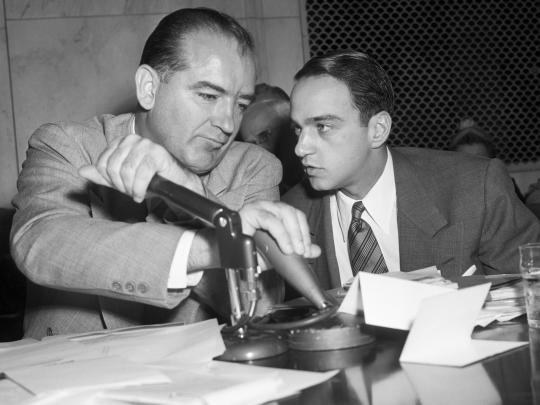
The movement resulted the outing and firing of hundreds of queer people from government jobs (ranging from politicians, clerks, military personnel, and contractors working with the government) with the State Department reporting that by 1953, they had fired 425 people under allegations of homosexuality. It also resulted in Dwight D. Eisenhower's Executive Order 10450, which fully barred any "homosexuals" from working any positions in the federal government.
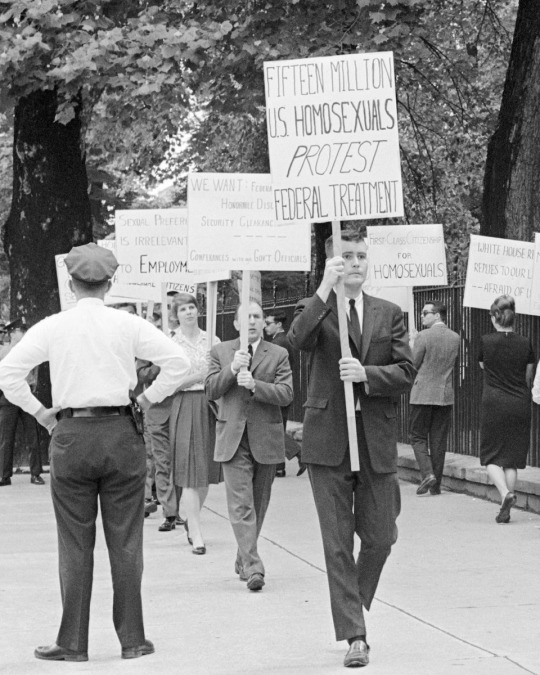
EO 10450 was partially repealed in 1975 largely in response to young men using claims of homosexuality to dodge the Vietnam draft, and again in 1995 when the Bill Clinton administration instituted the "Don't Ask Don't Tell" policy for military personnel. It wasn't fully and completely repealed until 1998 with the Bill Clinton passing Executive Order 13087, which prohibited any such discrimination in federal employment and wasn't EXPLICITLY repealed until Barack Obama's Executive Order 13764 wich took effect in 2017.

The cultural effect was an amplification of pre-existing societal homophobia to violent extremes and the promotion of the idea that queer people are inherently dangerous to "American freedom and democracy". Fun fact, Roy Cohn was actually a gay man who was very openly in sexual and romantic relationships with many men, even during The Lavender Scare, bit considered himself to be different from other gay men, basically because he was a dominant top. He died of AIDS while being part of the federal government's inaction campaign in response to the pandemic.

If you want to read more about it, the Wikipedia page is a decent place to start.
The point I was making in regards to there being a 2nd Lavender Scare happening right now is in reference to the growing wave of targeted transphobic policies and violence from the political right and the liberal inaction in response to it.
I'd say that this new Lavender Scare started in 2017 with Trump's banning of trans people from entering the military and has continued to the present day when it is rapidly escalating with no end in sight.

The main characteristics of this new scare, in my opinion are:
A targeting of trans people, gender non-conformity, and drag performance as subversive elements in society that pose a danger to the "traditional family", christian hegemony, and the wellbeing of children.
The platforming of extremist right-wing propaganda from various sources in mainstream media and political discourse, which all spout unified transphobic talking points that inspire discriminatory policies and violence through stochastic terrorism.
Transphobic policies being passed into law at a rapid pace on the state level in multiple states, with little to no federal intervention. (This refers to the US specifically)
Domestic stochastic terrorist attacks on queer spaces that prominently feature and support trans communities and drag performance, which are inspired by transphobic right-wing propaganda.
The boosting of TERF voices who pitch the same transphobic talking points as the right, from a pseudo-leftist perspective that serves as an alternate route of attack in the insemination of violent transphobia into the mainstream. (This is especially prevalent in the UK)
The "groomer" narrative, which links trans people, gender non-conformity, and drag performance to pedophilia in an effort to evoke strong emotional reactions from misinformed people prone to bigotry and reactionary thinking. This tactic can also be seen in action with the Q-Anon conspiracy cult.
Utilizing trans people, gender non-conformity, and drag performance as scapegoats for economic decline, political unrest, and poor quality of life in order to disract from the systems actually responsible for these problems.
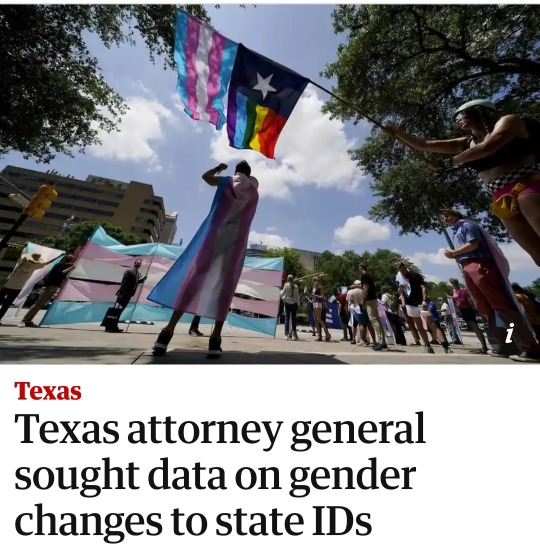
Link to article
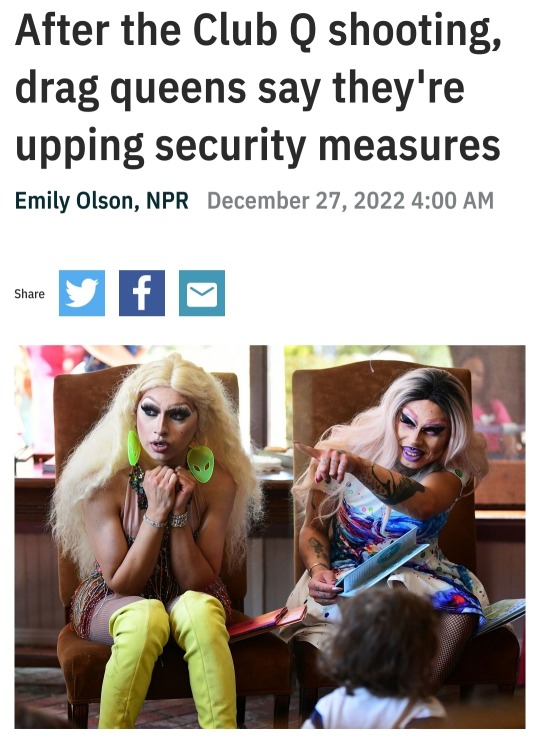
Link to article

Armed Proud Boy protest against the Holi-Drag Storytime in Columbus, Ohio, and counter protesters protecting the event.

Protesters against Florida's "Don't Say Gay" bill

Link to article
I would also like to add that unlike the 1st Lavender Scare, this is not just an American phenomenon but part of a clear and roughly coordinated multinational right-wing movement and is presenting just as prevalently in the UK (albeit in a slightly different form). It is dangerous to leave this reactionary movement unstated and unnamed, lest is become normalized.
#ask#anon#long post#the lavender scare#the 2nd Lavender scare#us history#us politics#politics#transphobia#homophobia#queer#trans#transgender#lgbtqipa#lgbtq+#nonbinary#gender noncomformity#gnc#drag#drag performance#informational
1K notes
·
View notes
Text


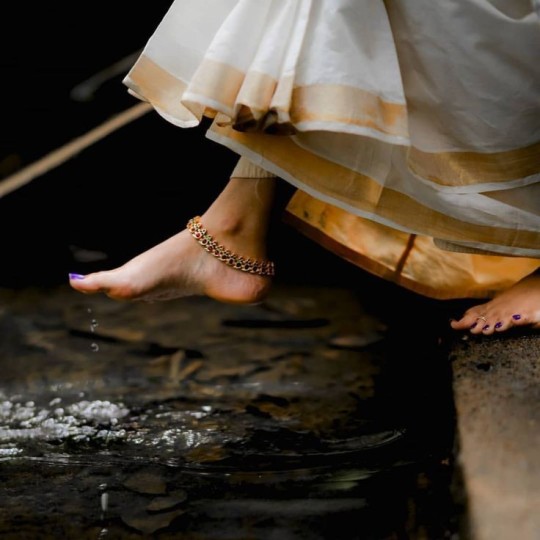
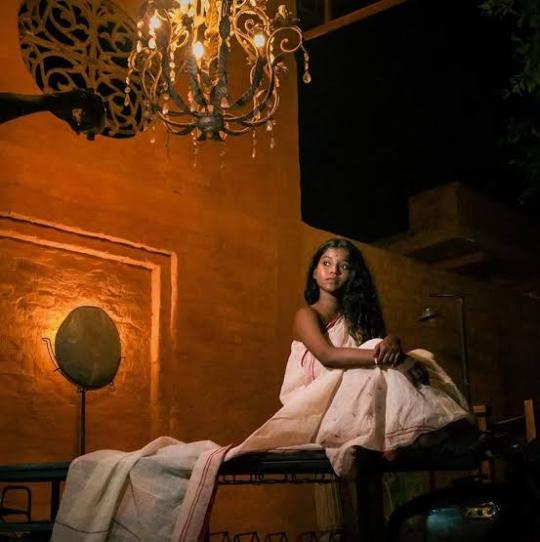

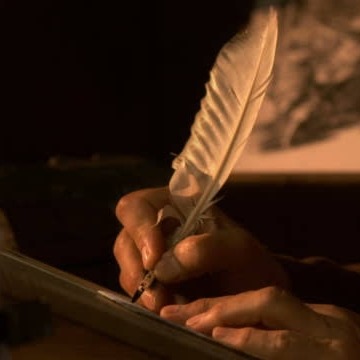

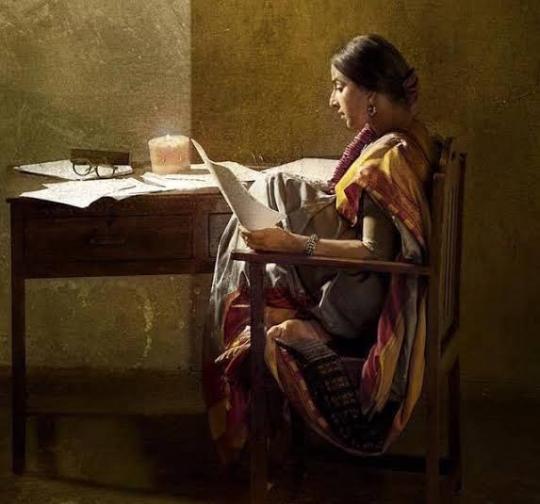
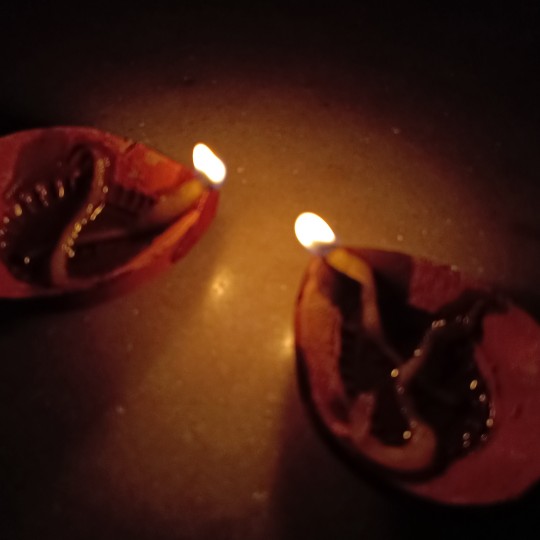
Khona was a poet and astronomer from Deulia village in Bengal, best known for Khonar Bochon, a series of couplets and short rhymes which imparts advice regarding agricultural and rural life. Born somewhere between 800-1200 A.D., Khona defied social and cultural norms of her time when women were rarely taught to read. Her husband Mihir was the son of the philosopher and astronomer Barahmihir, who was one of the navaratnas (nine gems) at the court of Chandragupta II. Khona lived in Chandragupta's court in Pataliputra for a time with her husband and father-in-law. According to legend, Chandragupta was so impressed with Khonar Bochon which benefited the farmers of his state that he named Khona the tenth gem of his court. Khonar Bochon remains relevant to the agricultural life of rural Bengal to the present day.
ষোল চাষে মূলা / তার অর্ধেক তুলা / তার অর্ধেক ধান / বিনা চাষে পান।
Translation: After 16 days of cultivation, radish cultivation in that land gives good yield. Cotton land requires 8 days of cultivation, paddy land after 4 days of cultivation gives good yield. Betel does not require cultivation.
1 / 2 / 3 / 4 / 5 / 6 / 7 / 8 / 9
#mb#khona#khonar bochon#khana#bengali academia#bangla tag#bangladesh#india#desi academia#dark academia#desi aesthetic#desi tag#desi tumblr#desiblr#bengali#indian history#ancient india#khonar bochor for anon#bengali literature
359 notes
·
View notes
Note
shiftythrifting (dot) com/post/730994707615842304/a-neat-little-photo-book-i-found-at-a-local-shop Do you think these are post-mortem photos? I personally doubt it.
Not post-mortem, no.
Everyone is worked up into a tizzy over the possibility that "the people in a Victorian photo could be DEAD and you MIGHT NOT EVEN KNOW IT!!!!
when in reality, you'd. you'd definitely know it. post-mortem photos are usually pretty obvious, because they're not really trying to make the people look awake and alive. either they're coffin photos, or they're of people in reclining positions. there is no such thing as a standing post-mortem photo or one where the subject is sitting fully upright; posing stands were flimsy things designed to help living people keep still during longer-than-modern exposure times. they cannot support dead weight. if a person is supporting themself in a photo, congrats- they're alive
if a person's eyes are fully open, they're alive
if it's being touted as "you'd never guess they were dead BUT-" they're alive. I saw one once which showed a (living) teen girl and claimed her body had been hung from the ceiling with wires to appear upright. corpse marionette action. and people call the actual Victorians morbid
in short, if they look awake and alive. they're alive. boring but true
360 notes
·
View notes
Note
Hey, I noticed that in one of your posts you showed an Iron Age Finnish woman's dress. Would you happen to have a good idea of what Finnish men were wearing in that era? The information on it seems sparse. I do have a relevant book that I'm about to look through, but I'd like to hear your insight too!
Hi! Thanks for the question (and sorry for the slow answer), I do love Finnish Iron Age clothing so it's always my pleasure to write about it. I've been wanting to do a deep dive into this for a long while, so maybe I'll do at some point a post about women's dress too.
Unfortunately no one has good idea of the Finnish Iron Age men's dress (and if you find any book or other source that claims otherwise, do not trust it), since there's much fewer archaeological finds of men's dress than women's dress. The most accepted theory on why the textiles of women's dress survived surprisingly well is because of the bronze ornamentation commonly sewn into especially the fine women's dresses of the era. The bronze protected them from decomposing fully. Presumably men's dresses were not decorated similarly then. There are some finds though and we can piece together at least some kind of vague picture.
I will be discussing the period from Viking Age to Crusade Age in Finland. Viking Age is often defined to cover 800s to mid-1000s and the Finnish Crusade Age started right after the Viking Age and ended in the end of 1200s, where the Finnish Medieval era begins. Crusade Age refers to the period where mostly Swedish (also German) crusaders in the span of couple of centuries conquered lands of the Baltic-Finnic pagans. The crusades of this period targeted pagans all over eastern Baltic Sea, including Baltic-Finnic Karelians, Livonians and Estonians, and Baltic peoples, and the Scandinavia too, where Sámi people were targeted. After that the Finland and Sápmi were colonized by Norse people and stayed that way untill Finland was transferred under Russian rule, but to this day Sápmi still stays under colonial rule, including Finnish colonial rule. The current Finland was very multicultural area, mostly populated by Finno-Ugric peoples, including Sámi people, Karelians and various Finnish peoples.
It's important to understand that even just Finnish peoples where not homogeneous, but had distinct, yet of course strongly related cultures. These were Finns (suomalaiset) (yes most people we now call Finns were not in fact called that) in the coast of southwestern and western Finland, Tavastians (hämäläiset) in central-western lake-Finland and Savonians (savolaiset) in central-eastern lake-Finland. This means we can't mix findings from all over Finland to reconstruct a dress without evidencing that all the elements were actually used in one place. These three tribes had broadly similar base for their clothes, but distinctive jewelry and detailing. The big divide was and has always been between eastern and western Finnish peoples. This is because western Finnish people were in close contact through the sea with Norse people and southern Baltic-Finnic peoples, while eastern Finnish people, Savonians mostly, were influenced a lot by their proximity with Karelians. Another dividing factor was the very different environmental conditions between western and eastern Finland. The Finnish coast especially in west is very flat and fertile land, while the lake area, especially in eastern Finland is very rocky, hilly and quite infertile. The main way it effected clothing differences was that western Finland being more wealthy had more elaborate clothing. Tavastians in both occasions fall quite in between, but they tended to be more in the western cultural camp.
My most important sources are a study by a doctor of cultural anthropology, Jenny Kangasvuo, Savon historia I (Savonian history) digitized and open sourced here and the digitized archeological collection of Finnish Heratage Agency. They are all in Finnish so not very useful for most people unfortunately.
Finnish Men's Dress in Viking and Crusader Ages
The basic garments men wore were broadly similar as women. They wore a shift/shirt, knee or above-knee length dress, cloak, belt, shoes and some kind of headwear. Wool was used most commonly, though the shirt would sometimes be linen too. Even evidence of silk has been found in some western Finland graves. I would assume that would be from a dress of some great man, who traveled to gain riches, possibly with vikings. Embroidery and decoration with metals was a typical feature of the whole Eastern Baltic Sea area. In Finland during this period bronze was the most common decorative metal, but silver was used too. Decorative elements were usually woven with small bronze spirals into all kinds of patterns. Here's examples from the reconstructed Ravattula's dress (Finns) used by women.
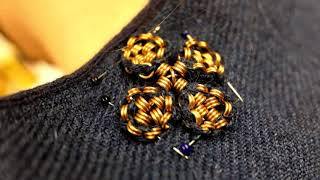

Shirt
The shirt (in Finnish shift of both women and men was called shirt) was basically a long shirt or under dress. We can assume it was similar to those of women's except shorter since the dress men wore was shorter too. They were made from wool or linen, I would assume wool was used in winter and linen in summer, when linen was even available. The neckline had a cut and closed with a bronze brooch. Horseshoe brooch was common. The first one is a quite typical bronze horseshoe brooch with a bit of ornamentation from Salo (Finns). The second one is from Tuukkala, (Savonians), it has exceptional ornate detailing and is uncommonly silver, not bronze. The third picture has two quite uniquely ornamented horseshoe brooches, first from Köyliö (Finns), second from Kurikka (Finns).
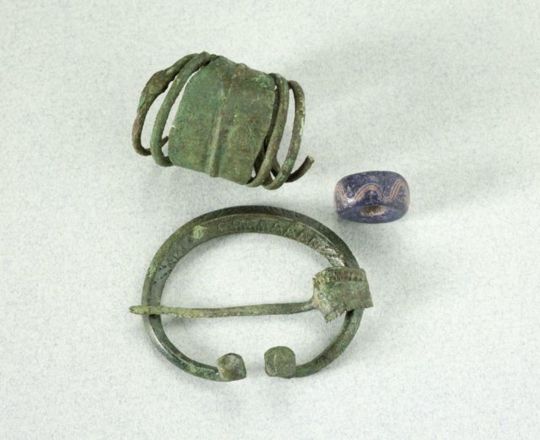
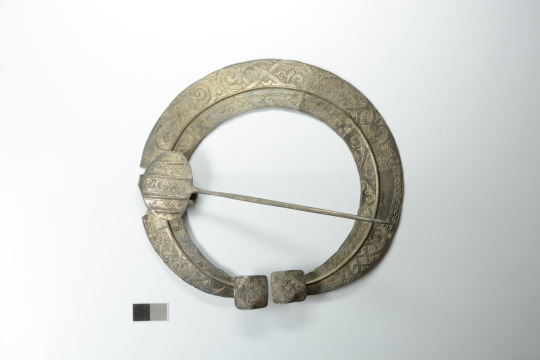
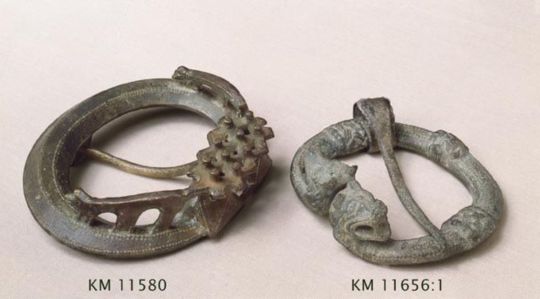
Legwear and footwear
Very little of men's legwear has survived and it's unclear weather men wore pants or separate pant legs, leg wraps or perhaps long socks. Evidence of strings decorated with bronze spirals and tablet woven band has been found in leg area of men's graves. This could mean that they wore either leg wraps, long sock or some sort of pant legs that needed to be secured with string or band under knee. Women used strings and tablet woven tape to secure leg wraps and socks, which I think supports that theory. Sometimes both bronze decorated string and tablet woven band was found in the leg area, which would still be explained by this theory, since it was common to decorate the ends of the bands with bronze decorated strings. Here's an example of sock bands just like that from the earlier mentioned reconstruction of the Ravattula's women's dress. Since men's dress was shorter, I think it would make sense if they still wore some kind of pants or separate pant legs with socks or leg wraps like that.
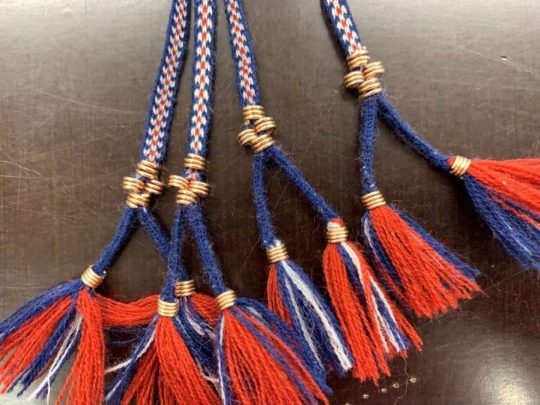
However, the strings and bands could have also been part of the shoes. Everyone probably wore similar shoes - laced leather shoes with a bit of pointed end. They might have been short or ankle length and the lacing was done with either leather cord or tablet woven band, which would also explain the findings. Socks or feet wraps would have been used in them, and straw or wool could be added as filling for warmth. Here's a pair of traditional Izhorian shoes from Estonia from early 1900s, and a pair of traditional Sámi shoes. The designs were likely roughly similar in Viking and Crusader Ages, though obviously more simple, and it's probable that Finnish shoes very something like that too. Here's a 1893 drawing of what findings of shoe material from Korpiselkä (Savonian or Karelian) might have looked like. Considering the quality of archaeology of that time, copious amounts of salt should be applied. And finally as a fourth picture there's reconstruction shoes from Ravattula's dress.


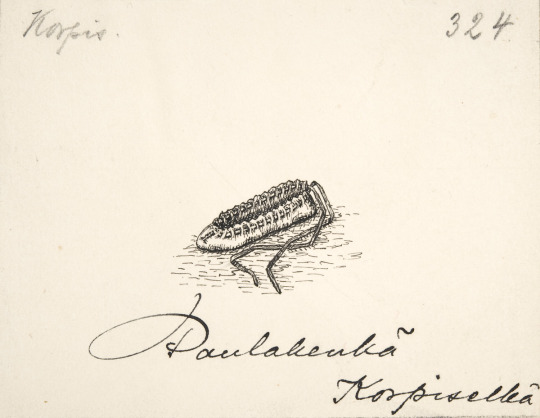
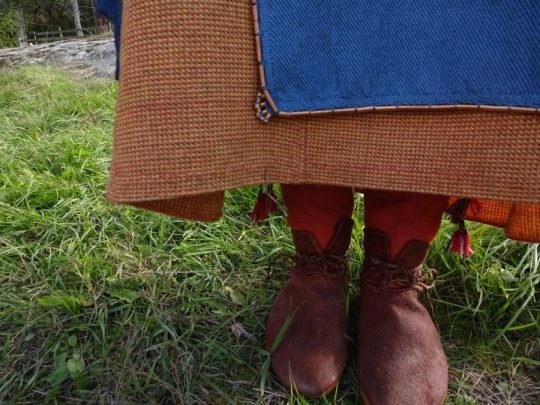
These are not necessarily mutually exclusive theories. The lacing of the shoe could have been laced up the leg and used also to secure either sock or leg wrapping, or they could have been separately secured in ankle and knee respectively.
In some graves twill fabric has been found in the leg area. It could be part of pants or for example leg wrapping, which was often made of twill. One theory about pants is that they were similar as some findings in Sweden, where fairly tight pants made of twill were secured at the hem with buttons similar to cuff studs. These kinds of cuff stud buttons are quite a common find in Finland and some have been found in men's graves close to legs.
Dress
Again there's not much findings of dresses, but a little more perhaps. It was usually from wool. The shape was either a tunic or an open coat. In Karelia there's findings of men's dress suggesting tunics thicker than women's dresses and made from sarka, a type of broadcloth. On the other hand, in Masku (Finns) they found buttons in a row on top of the torso, which suggest a coat closed with buttons. The first picture is a drawing of the grave find. Similary coak closing amounts of buttons have also been found in other places in western Finland. This suggests that Finns and probably Tavastians too wore long coats buttoned to the waist and Savonians wore tunic of Karelian influence. Below there's couple of version of what might this western Finnish men's coat dress could've looked like. The first is an imagined version of the coat based on the Masku grave finds, second is just as imagined version based on Eura (also Finns) grave finds.
Take these "reconstructions" with a strong dose of salt. These are more artistic reconstructions than scientific, since there's not enough material and too much guesswork needs to be done. And because we can see in the Masku grave drawing right here that the other deceased has a large buckle to (probably) close the shirt (to be fair, it could for a cloak too), like was typical, I find it implausible that the coat neckline would be small and round covering the buckle. If you make a decorated big buckle, I assume you want to show it. I would find a v-neckline more probable. It's also easier to make without wasting expensive fabric.

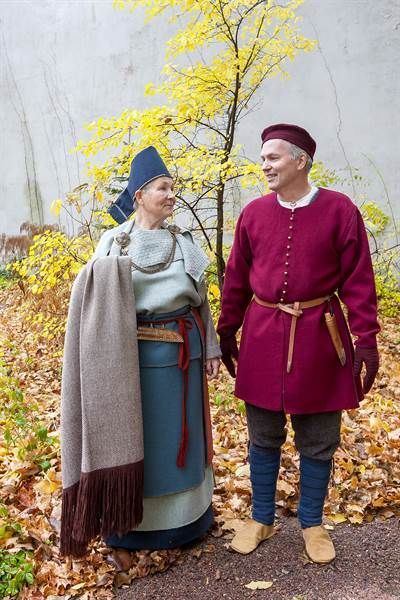

The buttons are interesting. There were what you would imagine - your typical buttons made of bronze like seen in the first artifact from Hattula (Tavastians). But then there was silver jingle bells used as buttons, found for example in both Masku and Eura graves, Eura findings pictured below.


It's possible, even probable I'd say, that the hemlines of men's dresses were finished with tablet weaving patterns, like women's dresses. Also I would assume the pattern of the men's dress (and shirt) was mostly similar to the women's underdress/shirt patterns. So here's couple of different reconstruction patterns for women's dress. Different historians have made different interpretations of the patterns, so it's very much undecided what it really was like.
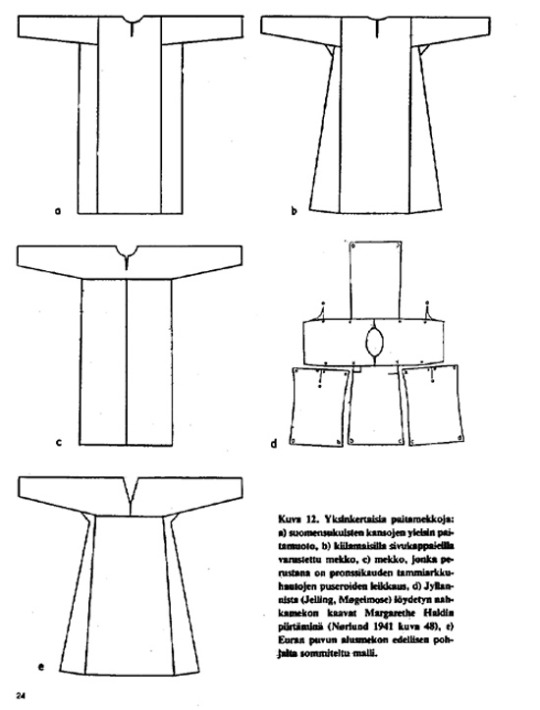
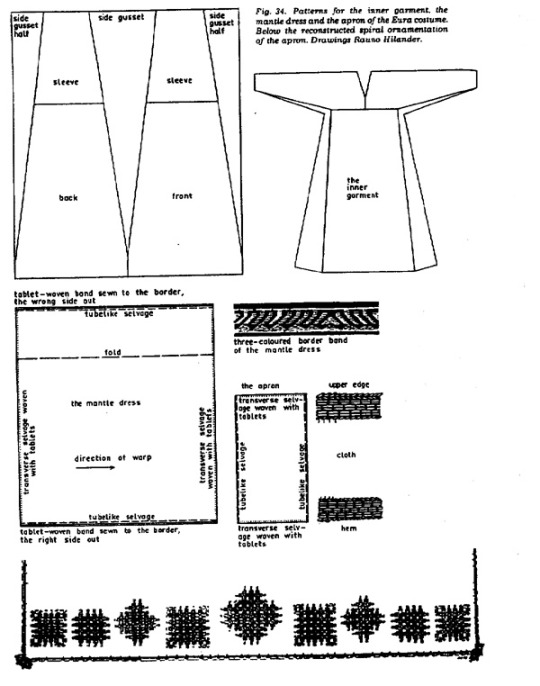
Belt
This is likely the most ornamental part of men's dress. They could be made out of leather or tablet woven band. And there's another east-west cultural divide here. Karelian belts were made out of leather, were usually 1,5-2,5 cm wide, decorated with iron or bronze studs and had a buckle made out of iron or bronze. These types of belts have been found in Savonia too, for example in Tuukkala grave find, which you can find very cool pictures of in this photo documentation of the dig in pages 173-175. In western Finland a "hela" belt was the common style. I don't think there's a world for hela in English. It's a sort of decorative lamella, small metallic plate (not necessarily square but often so) attached to fabric or leather with studs or sewing. Hela belt came from the Permians of Kama river, who were one of the many Finno-Ugric peoples who used to populate much of European side of Russia. Karelians lived closer to Permians, so you might think Permians would influence eastern Finland more, but my theory is that the costal Finns, who frequently joined viking crews and at least were in close contact with merchants including vikings, who would travel along the eastern route through the eastern European rivers, where they could go all the way to Kama river or at least meet traveling Permians. Here's yet another Finnish source more on the Finno-Ugric people around Kama river.
Anyway, hela belt was made of leather and filled with small decorated lamellas, often in square shape, but various other shapes too, like animal ornamentation. In this period hela belt helas were bronze. First image is a nice full set of hela belt metal pieces found in Pirkanmaa (Finns). Second is an older example, right before Viking Era, from Vaasa, costal settlement, (Finns), depicting a very Permian style. The third one is a lion hela found separately in Pälkäne (Tavastians). They are also found in Tuukkala, showing that both eastern and western cultural influences were present there at the same time.

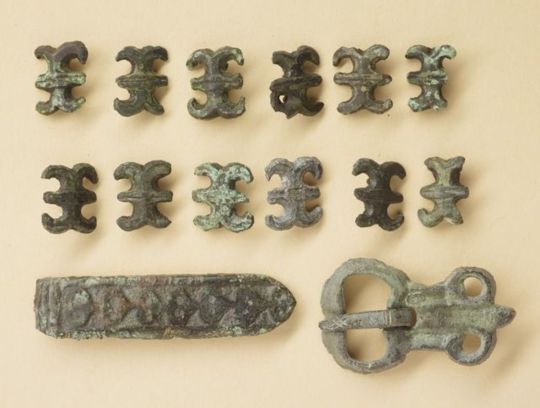
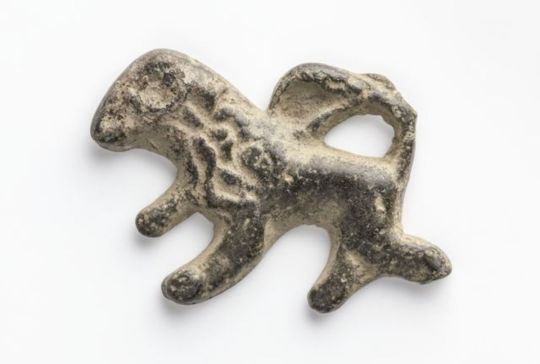
Another western Finnish belt type for men had intricate tassels decorated with bronze spirals hanging on the waist at the end of the belt. They could be made out of leather or tablet woven band. First image depicts a reconstruction of such tassel. Belts in east and west would have strap dividers to hang straps for things like purse, knife and sword. The first picture above has couple of those, but the second picture below has two more of them in more detail in the middle of the picture. These finds are from Lieto (Finns).


Cloak
Like women's cloak, men's cloak was woolen and either a square or trapezoid. Cloak is yet another east-west divide. In western Finland men's cloaks have embroidery with bronze spirals. They in fact appeared earlier in men's cloaks (in 900s) than in women's cloaks (1100s). They were also a little different in men's cloaks. The spirals and the patterns themselves were bigger and the fastening thread itself was also used for the pattern creation, unlike in women's dresses, where the thread was mostly covered. In eastern Finland there has been no finds of bronze decorations in men's cloaks, mostly only cloak brooches have been left of them. Unsurprisinly same applies to Karelia. This also means there's very little fabric left too. There's one exception. In Tuukkala (Savonians) they found a piece of fabric probably from men's cloak, though it could be from a men's dress too. It was striped, with possibly white or brown base and wide stripes of red, blue and yellow. So perhaps eastern Finnish cloak was not non-decorated, but the decoration was in the fabric pattern. Unfortunately it's hard to know how common fabric like that was, when so little of it is left.
Accessories
It's safe to assume men too wore some type of headwear, but none of those has survived. It probably means it was entirely made out of fabric whatever it was. Some type of hat or cap was certainly used in cold weather at the very least. Tablet woven headband was also possible option for not too cold weather.
In Tuukkala there was couple of interesting jewelry finds too. Two graves had a necklace type mostly found in Karelia. It was birchbark tape covered with nettle fabric and had square helas sewn into it. There were also more typical Finnish necklaces made of beads and bronze spirals.
Razors have also been found with men in their burials, so we can assume shaven faces or at least trimmed beards and moustaces were fashionable.
#dress history#historical fashion#historical clothing#fashion history#history#iron age dress#finnish iron age dress#finnish history#archaeology#answers#anon
221 notes
·
View notes